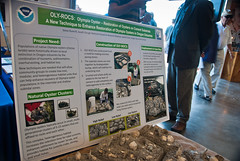Faithful blog followers: I regret to inform you that today’s post will most likely be my last post on the Sea Grant Scholars blog. I know, I know, what are you going to do with your spare time now? Do not fret, you can receive your weekly dose of AnnaRose adventures at AnnaRose and the Sea. This week marks my final week of working with Oregon Sea Grant. Come Friday, I will be leaving Corvallis and preparing for my journey
In regards to last week, I do not have much to report. My work days right now are pretty predictable. I’ll answer a lot of emails, make a couple phone calls, and go to a meeting or two. My main task for myself is to move forward on as many logistical details as possible before I finish at the end of this week. That said, a lot of my tasks have been getting contracts signed and preparing documents. One large, and slightly tedious, project I am working on is creating a comprehensive list with all the faculty from the Oregon University System that we want to try to invite to the workshop. While it is repetitive, it is interesting to learn about faculty doing marine research who I did not know about. Hopefully, by the time I leave at the end of this week, the major logistical kinks will be worked out so that thing will run smoothly for others that will be planning the event.
Thanks to those who followed my posts! Stay tuned to my other blog for updates on my continued adventures in marine science and policy. As part of my final post, I will leave you with a section of my Reflection Essay for the final portfolio of my internship:
The sum of both my summer experiences with Oregon Sea Grant has significantly shaped my career aspirations. In short, I have learned that I find marine policy very interesting, particularly CMSP, but in order to be at a level of influence to where I am satisfied with my job I need to obtain a PhD and more career experience. The policy world is very hierarchical and my experience has made it very apparent to me that I need at minimum a Master’s degree before I can make a meaningful contribution towards marine management.
An ongoing internal debate I had throughout my last couple years of college was whether I was going to choose a graduate path in science or policy. Largely as a result of what I have learned from my Sea Grant experiences, I have decided that I am going to pursue a PhD in the sciences and spend my early-career as a research scientist. Quite often, scientists who are established in their field will be called to contribute to policy and management decisions. My hope is that by starting in science, I will later be able to contribute to policy in a meaningful way.
Another way Oregon Sea Grant has significantly influenced my career decision is by exposing me to Coastal and Marine Spatial Planning. Throughout this past year, I had been entertaining the idea of incorporating geospatial science into my academic repertoire. Learning about CMSP and the importance of science that orients marine data geospatially has prompted me to pursue a Graduate Certificate in Geographic Information Systems (GIS) this coming January. After obtaining my GIS certificate, I intend to apply to graduate school next fall. My plan is to pursue a PhD in coral reef biogeography, studying spatial patterns in reef ecosystems in response to climate change and habitat fragmentation.
Pasa bon dia,
AR









